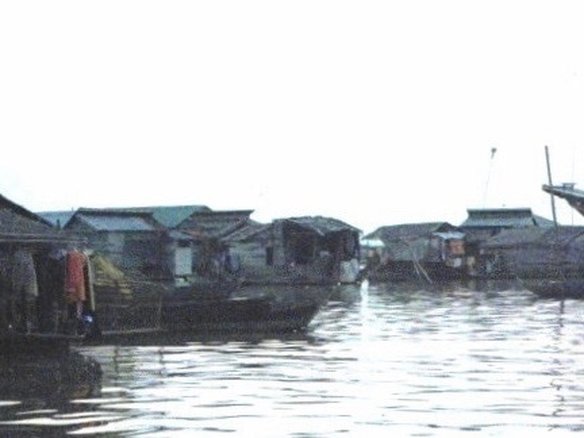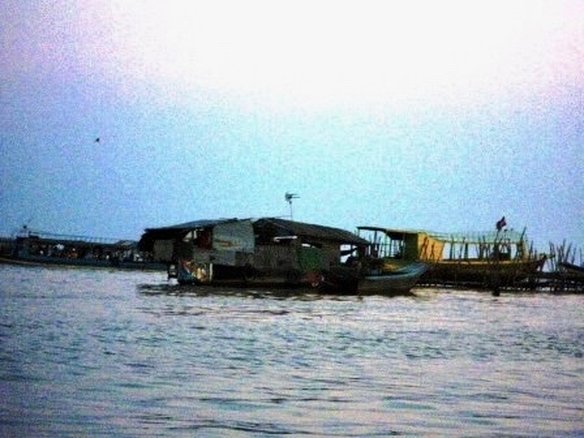Tonle Sap: Cambodia's Environmental Hotspot
In Khmer, Tonle Sap means Large Fresh Water. More commonly, it is now translated as Great Lake. A combined lake and river system, the Tonle Sap is the largest body of fresh water in Southeast Asia. It is also one of the most productive water ecosystems in the world.
What Is Unique About Tonle Sap?
Designated as a UNESCO biosphere reserve in 1997, the Tonle Sap is unique in that it changes the direction of its flow as the lake portions expands or shrinks depending on the seasons.
During the dry season from November to May, the Tonle Sap drains into the Mekong and when the rains come back, the Tonle Sap changes course to form the enormous Tonle Sap lake.
This direction reversal is celebrated in the now world famous full moon and water festival or Bon Om Touk in Phnom Penh and you really should see this world wonder.
Designated as a UNESCO biosphere reserve in 1997, the Tonle Sap is unique in that it changes the direction of its flow as the lake portions expands or shrinks depending on the seasons.
During the dry season from November to May, the Tonle Sap drains into the Mekong and when the rains come back, the Tonle Sap changes course to form the enormous Tonle Sap lake.
This direction reversal is celebrated in the now world famous full moon and water festival or Bon Om Touk in Phnom Penh and you really should see this world wonder.
Tonle Sap: Environmental Hot Spot in Southeast Asia
This inland wetland, the Tonle Sap is an environmental hotspot in Southeast Asia. During the dry season, it covers an area of about 250,000-300,000 hectares. Multiply this by 5 times more during the rainy season.
It is the breeding place for fish that migrate down the Mekong and its many tributaries in various countries. It also acts as the reservoir from which water drains in the dry season, thereby, managing the salinity in the Mekong Delta.
This inland wetland, the Tonle Sap is an environmental hotspot in Southeast Asia. During the dry season, it covers an area of about 250,000-300,000 hectares. Multiply this by 5 times more during the rainy season.
It is the breeding place for fish that migrate down the Mekong and its many tributaries in various countries. It also acts as the reservoir from which water drains in the dry season, thereby, managing the salinity in the Mekong Delta.
In the dry season, the Tonle Sap Lake is about a meter deep most of the time and covers an area of 2,700 square kms. but when the water reverses its flow and dumps Mekong water into the lake, this area expands to 16,000 square kms and 9 meters deep, flooding abutting fields and forests providing breeding places for fish and making the Tonle Sap one of the most productive inland fishing grounds in the world.
It supports around 70 per cent of Cambodia's protein intake and providing livelihood for the people living in the provinces that abut this lake.
It supports around 70 per cent of Cambodia's protein intake and providing livelihood for the people living in the provinces that abut this lake.
But it's also a highway, and you can travel up the Tonle Sap in good boats and really get a sense of the importance of river routes to history. And we haven't even mentioned birds and wildlife and river plants that form another staple of local diets
Tonle Sap is important to the continued existence of many species. It supports about 42 species of reptiles, some 225 species of birds, 46 mammals species, 46 species of zooplankton, 57species of benthic invertebrates, 107 fish species and about 200 plants.
Tonle Sap is important to the continued existence of many species. It supports about 42 species of reptiles, some 225 species of birds, 46 mammals species, 46 species of zooplankton, 57species of benthic invertebrates, 107 fish species and about 200 plants.
The Tonle Sap Biosphere Reserve
Nine Cambodia provinces comprise the Tonle Sap Biosphere Reserve, namely, Banteay Meanchey, Battambang, Kampong Chhnang, Kampong Thom, Preah Vihear, Pursat, Siem Reap, Otdar Meanchey and Krong Pailin. Even if Tonle Sap is considered Cambodia's horn of plenty, poverty is severe in most of these provinces.
Many international agencies focus their energy on the basin both to stop over development and to help the fishers strengthen family income through integrated development. What does that mean?
Well, improving fishing doesn't help if you don't improve the roads to the markets and improve refrigerated storage and on and on. And you can see all this if you travel here.
Nine Cambodia provinces comprise the Tonle Sap Biosphere Reserve, namely, Banteay Meanchey, Battambang, Kampong Chhnang, Kampong Thom, Preah Vihear, Pursat, Siem Reap, Otdar Meanchey and Krong Pailin. Even if Tonle Sap is considered Cambodia's horn of plenty, poverty is severe in most of these provinces.
Many international agencies focus their energy on the basin both to stop over development and to help the fishers strengthen family income through integrated development. What does that mean?
Well, improving fishing doesn't help if you don't improve the roads to the markets and improve refrigerated storage and on and on. And you can see all this if you travel here.
Tonle Sap Development
Progress in development and environmental conservation has been made after the biosphere reserve initiative has been put in place.
Observed were improvements on livelihood, infrastructure, environment maintenance and increase in fish production. More flooded forests and mangroves as well as the come back of endangered species have also been noted.
People in the area now have better access to financial and technical assistance especially in proper fishing, livestock raising and farming.
Progress in development and environmental conservation has been made after the biosphere reserve initiative has been put in place.
Observed were improvements on livelihood, infrastructure, environment maintenance and increase in fish production. More flooded forests and mangroves as well as the come back of endangered species have also been noted.
People in the area now have better access to financial and technical assistance especially in proper fishing, livestock raising and farming.
More schools and health centers have also been opened to serve the area noting the access to education especially for girls. Some of the development projects in Tonle Sap include:
- The Tonle Sap Conservation Project (19.8 million)
- The Tonle Sap Environment Management Project (19.86 million)
- The Tonle Sap Rural Water Supply and Sanitation (24 million)
- The Tonle Sap Sustainable Livelihoods (20.3 million)
- The Tonle Sap Lowland Rural Development Project (24 million)
A River Culture of About 3.6 Million
30% of Cambodia's population live in Tonle Sap and get their living from this source. If you take the river as your highway from Phnom Penh to Siem Reap, you'll be richly rewarded by watching these intrepid fishers.
Floating villages are many. There seems to be one in every province. The one in Siem Reap has become a tourist destination but it is the easiest for tourists to go to as they can easily spend an afternoon or evening there after visiting the temples of Angkor.
30% of Cambodia's population live in Tonle Sap and get their living from this source. If you take the river as your highway from Phnom Penh to Siem Reap, you'll be richly rewarded by watching these intrepid fishers.
Floating villages are many. There seems to be one in every province. The one in Siem Reap has become a tourist destination but it is the easiest for tourists to go to as they can easily spend an afternoon or evening there after visiting the temples of Angkor.
The Tonle Sap is home to many ethnic Vietnamese who immigrated to Cambodia some about 100 years ago. Their floating settlements have become one of the great attractions in Siem Reap, very close to the Angkor.
You can rent a boat after a day of temple bashing and just float among the village folk as they get about their business after sunset. As the tourist boats arrive, the ethnic Vietnamese come paddling over in boats loaded with children holding snakes and other exotic animals as well as women with beautifiul crafts and products.
You can rent a boat after a day of temple bashing and just float among the village folk as they get about their business after sunset. As the tourist boats arrive, the ethnic Vietnamese come paddling over in boats loaded with children holding snakes and other exotic animals as well as women with beautifiul crafts and products.
Life in Tonle Sap's Floating Village
In the village is a big store and restaurant, and you can see crocodiles in their cages. The residents get about their lives jumping from one boat to another to buy things from the corner store, visit their neighbors or go to a karaoke bar.
It is not unusual for the propeller boats to get stuck going and coming form the village but it is a village life one seldom sees and they all pitch in to help each other. This is totally different from the Thai floating market.
It makes a great evening and a fantastic contrast to downtown Bangkok! It's no more the "real" Asia than the cities, but it is an important part of the reality and should not be missed.
In the village is a big store and restaurant, and you can see crocodiles in their cages. The residents get about their lives jumping from one boat to another to buy things from the corner store, visit their neighbors or go to a karaoke bar.
It is not unusual for the propeller boats to get stuck going and coming form the village but it is a village life one seldom sees and they all pitch in to help each other. This is totally different from the Thai floating market.
It makes a great evening and a fantastic contrast to downtown Bangkok! It's no more the "real" Asia than the cities, but it is an important part of the reality and should not be missed.

